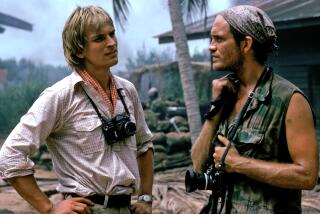From the house that built art house
- Share via
THERE is one boxed set above all that cinephiles are craving this holiday season: the 50-film “Essential Art House: 50 Years of Janus Films.”
As you’d expect from the perfectionists at the Criterion Collection, which collaborated with Janus (its sister company) on the set, it’s a gorgeous object, not to mention a hefty one: a 14-pound brick handsomely bound in brown cloth and embossed with the company’s famous two-faced icon. Included is a 240-page hardcover book that contains original poster art, essays by Martin Scorsese and film scholar Peter Cowie, and credits and stills for all 50 films. The list price is $850, though many online retailers are selling it for between $600 and $650. That’s $12 to $13 a disc; not bad at all, since there’s hardly a film here not worth getting to know intimately.
Janus Films was founded in Boston in March 1956 by Bryant Haliday, a film and stage actor, and Cyrus Harvey, his fellow Harvard alum. They owned the Brattle Theatre in Cambridge, Mass., and the 55th Street Playhouse in Manhattan, and formed a distribution company to help fill their screens and to capitalize on what was still a largely untapped foreign film market.
Janus scored its first major hit in 1958 with Ingmar Bergman’s philosophical danse macabre “The Seventh Seal” but struggled financially until the mid-1960s, when ownership of the company changed hands. Under William Becker, a friend of the founders, and Saul Turell, a documentary filmmaker, Janus expanded its focus beyond first-run acquisitions and embarked on the mission that has ensured its longevity: building a library of international art cinema. With the growing repertory circuit in mind, Becker and Turell went about snapping up rights for classic films with expired licensing deals. (Their sons are now in charge of the family business: Peter Becker is president of Criterion and Jonathan Turell is managing director of Janus.)
It was a combination of taste and foresight that made Janus a key player in the development of film culture in this country. Implicit in the Janus project was a belief -- not by any means a consensus back in the day or even now -- that movies are art and should be treated as such. As Scorsese notes in his brief essay, the Janus brand soon came to signify quality. Of the black-and-white logo that preceded each film, he writes: “It meant something -- that you were going to see something special, something new, something completely different from anything you’d ever seen before.”
That sense of discovery awaits any budding film buff who cracks open “Essential Art House.” From its sheer weight to its definitive title, the box conveys the authority of a canon. Many of the usual suspects that reside on critics’ all-time lists are here (Jean Renoir’s “The Rules of the Game,” Fritz Lang’s “M”). So too the filmmakers that Janus helped put on the map (and vice versa): Bergman (with three films), Federico Fellini and Francois Truffaut (two apiece). The selection reflects the Eurocentric slant of the art-film canon, but Janus also popularized Japanese masters such as Akira Kurosawa (three films in the box) and Yasujiro Ozu (one) and championed their counterparts who never attained the worldwide reputation they deserved: Kenji Mizoguchi, represented here with the sublime supernatural folk tale “Ugetsu” (1958), and Kon Ichikawa, with the harrowing (anti-)war movie “Fires on the Plain” (1959).
The box draws heavily from what is often called -- in wistful terms, by film snobs of a certain age -- “the golden age of the art house”: 41 of the 50 titles date from before 1960 (nearly half are from the ‘50s alone). But the Janus enterprise is less about nostalgia than posterity. Explaining why they named their distribution house for the Roman god of open doors, founder Cyrus Harvey said, “One face was facing art; the other, commerce.” In time, the double-faced deity also became a perfect emblem for a company that realized the importance of the long view -- of keeping one eye on history and the other on the future.
More to Read
Only good movies
Get the Indie Focus newsletter, Mark Olsen's weekly guide to the world of cinema.
You may occasionally receive promotional content from the Los Angeles Times.








